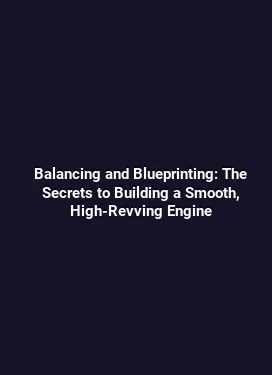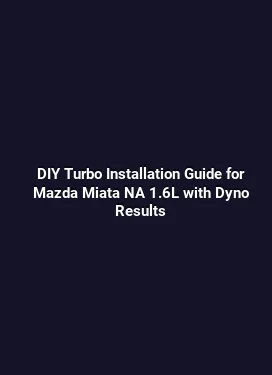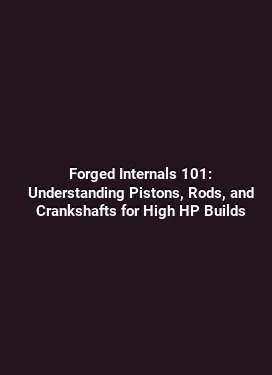Upgrading Your Fuel Delivery: Pumps, Rails, and Regulators for High Flow
Modern performance engines demand a precise, reliable supply of fuel to sustain horsepower and torque across wide RPM bands. Upgrading the core fuel delivery system—comprising the pump, rail(s), and regulator—can unlock meaningful gains in power, throttle response, and drivability. This guide delves into practical considerations, selection criteria, installation nuances, and tuning strategies that help enthusiasts achieve higher fuel flow without sacrificing reliability.
Understanding the Role of Each Component in a High-Flow System

The fuel system is a coordinated network that must deliver consistent pressure and volume under varying load and engine speeds. Pumps determine how quickly fuel is moved from the tank to the engine. Rails provide the mounting and distribution backbone that feeds each injector with stable pressure. Regulators regulate pressure and help manage return flow, ensuring the engine receives the correct amount of fuel under different operating conditions. A high-flow setup optimizes these elements to reduce pressure drops, mitigate pulsation, and support larger injectors or forced induction upgrades.
Key performance outcomes from a thoughtfully engineered system include higher peak horsepower, improved wide-open-throttle (WOT) fueling stability, quicker throttle response, and more consistent fueling during sustained high-RPM operation. While a larger pump or regulator can technically increase fuel delivery, the gains are meaningful only when matched with compatible injectors, a properly tuned engine control strategy, and proven fuel delivery hardware that can withstand elevated pressures and temperatures.
Selecting a High-Flow Fuel Pump: Flow, Pressure, and Reliability
Choosing the right pump begins with understanding the engine’s fuel requirements at peak power. High-flow pumps are rated by both flow rate (gallons per hour or liters per hour) and the maximum pressure they can sustain without cavitation. For engines pushing toward higher horsepower, it’s common to select a pump rated for significantly more fuel than the stock system, with a practical safety margin to account for fuel temperature, tank level, and line routing.
Several practical criteria guide pump selection: - Flow capacity at the target fuel pressure: Pumps perform differently as pressure rises. It’s essential to verify flow curves that match the engine’s pressure targets during boost or high-RPM operation. - Compatibility with returnless vs return-type systems: Some setups rely on return lines to dissipate excess pressure, while others use a regulator at the rail to manage pressure without a return. The chosen pump should align with the overall strategy. - Reliability under heat and vibration: The pump operates in a challenging environment. Electronics, seals, and bearings should handle sustained operation without overheating or failing. - Size and installation practicality: Barbed fittings, clamp sizes, and pump mounting must fit the vehicle geometry and tank access. EFI-specific supplies often include robust harnesses and connectors for secure electrical integration.
In practice, a popular approach is to pair a high-flow pump with an appropriate fuel filter, ensuring filtration before the pump to reduce debris-induced wear. Additionally, considering a fuel pressure damper or pulsation absorber can help minimize pressure fluctuations that propagate through the line and into the rail.
Key considerations when upgrading pumps

When evaluating pump options, look for a model with a proven track record in high-performance applications, a solid warranty, and compatibility with your vehicle’s fuel system topology. It’s also wise to assess fuel compatibility (gasoline, ethanol blends, or E85) because some pumps are optimized for specific mixtures. Don’t underestimate wiring quality; a robust power supply, proper grounding, and current-rated relays are essential to prevent voltage drop and pump stalling during critical acceleration periods.
Fuel Rails: Distribution, Volume, and Stability
Fuel rails act as the distribution hub that delivers uniform pressure to each injector. An upgraded rail system often features larger bore passages, improved internal flow paths, and dedicated mounting provisions for high-flow injectors. A well-designed rail minimizes flow resistance and reduces the likelihood of pressure drop across cylinders, especially under high load and boost conditions.
Important rail considerations include: - Volume and stagnation: Sufficient internal volume dampens pressure spikes and helps maintain stable pressure during rapid throttle changes. - Porting and cross-section: Optimized cross-sectional area reduces bottlenecks. Some rails use oval or rectangular shapes to maximize flow while fitting within tight engine bays. - Orientation and compatibility: Rail height and injector spacing must align with intake manifolds and injector hardware. Some installs require adapter kits to ensure an airtight seal and proper line routing. - Material and finish: Aluminum rails offer strength and heat resistance, while stainless variants can improve durability in extreme conditions. Surface finishes may influence heat absorption and corrosion resistance over time.
For engines running higher boost pressures or larger injectors, rails with integrated pressure testing ports and fuel-pressure measurement taps provide valuable monitoring capabilities. These features enable precise diagnostics of pressure consistency across cylinders, contributing to more reliable tuning and engine safety.
Rail selection strategies for different applications
Naturally aspirated builds with mild to moderate power gains benefit from rails designed for consistent flow and compatibility with existing injectors. Turbocharged or supercharged setups often require rails that minimize turbulence and pressure drop under boosted conditions. In either case, pairing rails with compatible injectors and a capable regulator ensures uniform distribution across the bank, reducing the risk of lean or rich conditions in individual cylinders.
Fuel Regulators: Precision Control and System Architecture
A regulator governs the pressure difference between the supply side and the engine’s demand side. High-flow regulators are designed to maintain stable pressure across a broad operating window, including during sustained high-RPM operation and boost. Regulators must work in concert with the pump and rails to ensure the engineered fuel pressure aligns with the engine’s fueling strategy.
There are two broad regulator architectures: - In-line regulators: Mounted along the supply line, these regulators set a target pressure that the pump must overcome to maintain fuel system pressure. They are common in return-type systems where excess fuel is shed back to the tank. - Integrated regulators: Found in some high-performance setups, these regulators may reside near the rail or in the fuel delivery module. They often pair with returnless systems and may incorporate pressure sensing for ECU feedback.
Key regulator features to consider include: - Pressure range and stability: The regulator should hold the target pressure across engine speed and boost variations. Some designs offer lower spring tension for improved aberration control at low demand, while others lean toward higher setpoints for aggressive fueling strategies. - Response time: Fast regulator response minimizes transient pressure dips during quick throttle changes or gear shifts, improving fueling accuracy. - Vacuum/boost reference compatibility: In turbocharged configurations, an appropriate reference port ensures the regulator responds to boost pressure, maintaining consistent fueling as boost levels rise. - Return path integrity: If a return-type system is used, the regulator must route excess fuel efficiently to the tank without causing excessive heat buildup or pressure waves.
Regulator tuning for reliability and performance
Regulator tuning exists at the intersection of safety and performance. Start with a conservative baseline that matches the injector size and target horsepower. Monitor fuel pressure at idle, mid-RPM, and under boost to verify stability. If pressure swings are observed, examine hose routing for kinks, inspect the regulator’s diaphragms for wear, and verify that the return line flow is adequate. Ensuring proper venting and avoiding trapped air in low spots helps maintain predictable pressure behavior, especially after long drivelines or steep inclines where static fuel column height can impact readings.
Wiring, Electrical, and System Integration Essentials
An upgraded fuel delivery system is only as effective as its electrical integration. A high-flow pump draws more current, which can place additional demands on the vehicle’s electrical system. Using a dedicated relay, an appropriate fuse rating, and ensuring solid ground connections minimizes voltage drop that could cause pump instability or intermittent fueling during aggressive driving scenarios.
Harness loom routing should avoid heat sources, moving parts, and sharp edges. Securing the harness with proper clamps reduces wear and prevents chafing. In modern engines, many pumps integrate with electronic control units via a dedicated ground and power feed; verifying compatibility with the vehicle’s ECU and any associated fuel-trim strategies helps avoid fueling delays or misfires during rapid throttle transitions.
Practical wiring and installation tips
Use a dedicated power supply rail or an isolated power line to the fuel pump, separate from accessory circuits to minimize interference. Install a quality fuel pressure sensor with a clear diagnostic path to the ECU or data-logging system, enabling precise mapping of pressure behavior under different driving conditions. If the vehicle uses a return-type system, ensure the return line is sized to handle the increased flow without contributing to temperature rise or line restrictions.
Installation Considerations and Real-World Scenarios
Executing a high-flow upgrade requires thoughtful planning beyond part selection. The following scenarios illustrate how these components interact in real-world builds:
Scenario A: Naturally aspirated engine with a moderate power goal. Upgrading the pump and regulator provides a more stable fueling baseline, but you may not need oversized rails. Focus on ensuring clean fuel pressure delivery across the RPM range and verify that injector dynamics remain within optimal duty cycles. Monitor for heat soak in the fuel line during long climbs or heavy pulls, and consider a fuel cooler if applicable to the heat management strategy.
Scenario B: Forced induction with significant horsepower targets. This setup benefits from a high-capacity pump, large-diameter rails, and a regulator designed for boost-reference operation. Expect more critical attention to injector timing, pressure drop across the rail, and the potential need for a return-type architecture to prevent pressure runaway under boost. Tune for a stable fuel map that resists lean conditions during spool and peak boost windows.
Scenario C: Ethanol-compatible systems. Ethanol blends require higher injector flow and robust fuel delivery to manage the extra heat of combustion and potential volatility of the fuel. Select pumps and regulators rated for ethanol compatibility, and verify that seals and O-rings resist ethanol-induced degradation. Regularly inspect filters for fuel contamination that can exacerbate injector wear and reduce flow efficiency.
Monitoring, Diagnostics, and Performance Feedback
Effective upgrades combine hardware with data-driven monitoring. Install a reliable fuel pressure gauge or sensor that allows continuous monitoring across idle to high-RPM operation. Data logging can reveal subtle fueling disparities across cylinders, helping identify leaks, valve train interactions, or sensor drift. In many builds, the combination of consistent pressure, stable rail temperature, and well-matched injector size translates into better throttle response and a more linear power delivery curve.
Interpreting the data requires a holistic view of the engine’s fueling strategy. Pay attention to injector duty cycle, pump current draw, rail temperature readings, and the presence of any fuel-rich or fuel-lean excursions during transitions. A synchronized approach—where the pump, rail, regulator, and injectors are calibrated to operate within a cohesive map—yields the most meaningful performance gains and ensures long-term durability of the fuel system components.
Common Pitfalls and How to Avoid Them
Upgrading fuel delivery is not without risk. Common missteps include selecting a pump with insufficient headroom for anticipated power, underestimating the importance of heat management in the supply lines, and neglecting the electrical system’s ability to sustain peak pump demand. Another frequent issue is installing rails and regulators that appear compatible on paper but create a pressure drop due to ill-fitting seals or misaligned injector ports. meticulous fitment checks, proper sealing, and adherence to torque specifications help prevent these problems.
Additionally, ensure compatibility with other components such as fuel filters, pick-up tubes, and tank baffling. A poorly baffled tank can cause fuel slosh that introduces pressure fluctuations, particularly in cornering or high-G maneuvers. In racing or track-day contexts, consider a surge tank to further stabilize the supply and minimize cavitation during sustained high-load events.
Integration with Modern Tuning Practices
As engines and ECUs evolve, trend-conscious builders leverage data-driven tuning approaches that align fuel delivery with air metering, ignition timing, and boost control. The use of high-flow pumps, rails, and regulators enables more aggressive fueling strategies while maintaining safe margins. Track-focused or performance-oriented street cars benefit from repeatable fueling behavior, where the right hardware combination reduces the likelihood of lean spikes during shifts or rapid throttle changes. Embracing a holistic, modular upgrade path—where each component supports the next—helps ensure reliability and measurable performance improvements without compromising everyday drivability.
Maintenance and lifecycle considerations
Regular maintenance extends the life of a high-flow fuel system. Schedule periodic checks of pump electrical connectors, inspect rails for any signs of fuel seepage, and replace filters according to the manufacturer’s recommendations or track-use guidelines. For ethanol blends, monitor any signs of material degradation and maintain seals that resist chemical exposure. A proactive maintenance approach helps sustain consistent fueling behavior and avoids sudden performance degradation in demanding conditions.
Long-Term Performance Benefits and Real-World Outcomes
Investing in a thoughtfully designed high-flow fuel delivery system yields tangible benefits over the vehicle’s lifespan. Consistent fuel pressure across the RPM spectrum supports higher torque delivery, smoother torque curves, and improved mid-range response. In boosted applications, the ability to sustain fuel flow during peak boost contributes to safer engine operation and improved reliability under aggressive driving conditions. The combination of stable pressure, robust electrical integration, and well-matched injectors ultimately translates into a more confident driving experience and measurable performance gains on the road or track.
First H2 and First H3 Labels
This final section reinforces the structure of the article and demonstrates how H2 and H3 headings organize the content for readability and SEO clarity. The content above is designed to flow naturally, delivering in-depth information without breaking the reader’s immersion. By addressing pump selection, rail design, regulator behavior, electrical integration, installation nuances, and tuning strategies, readers gain a comprehensive understanding of how to upgrade fuel delivery for high-flow applications.






